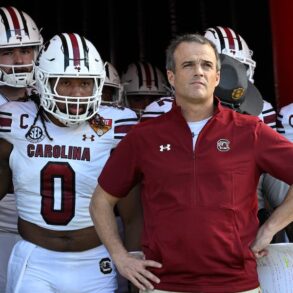ASHEVILLE, N.C. — Can you imagine a summer signing day in college football? What about a single transfer portal? How about spring practices shifted to June?
Those are the questions expected to be answered by members of a new committee of power conference administrators exploring ways to overhaul a 365-day college football calendar that was originally built for an amateurism system. College executives are reinventing a dated calendar to marry with the House settlement-related athlete-revenue sharing model set to begin July 1.
Advertisement
And they are on the clock to do it.
“It is imperative to our industry that we make this decision on the calendar by July 1,” Washington athletic director Pat Chun told Yahoo Sports from Orlando last week at a gathering of athletic administrators. “Once July 1 hits, teams will start tracking for 2026. We need to know the calendar.”
Here in Asheville, North Carolina, this week, the 32 Division I conference commissioners gather for their annual summer meeting, where a host of items are on the agenda: the future of NCAA governance (will a separate division be created for the power leagues?); the College Football Playoff format (will adjustments to the selection criteria appease the Big Ten and SEC?); the NCAA tournament (is expansion happening or not?); and the many unsettled concepts tethered to the industry’s landmark move to share revenue directly with athletes.
Advertisement
Of all the decisions that administrators must make in the wake of the settlement’s approval, the football calendar is, perhaps, the most pressing of them. Making matters more difficult is that they don’t agree on the most critical piece: the timing of the transfer portal.
Should it be in January or April?
A fight is brewing
While the majority of coaches want a 10-day portal period in early January, many administrators, as well as coaches in the Big Ten, are supporting an April portal date as a way to more align the portal with the academic calendar (ending in May) and a school’s new revenue share cap year (ending in June).
Advertisement
The portal’s date not only impacts decisions on spring practice but it may determine if a second portal window will continue to exist. For instance, SEC coaches, hell bent on a January portal date, agreed last month that they’d prefer keeping two portal windows over a single window in April.
College football’s leaders are torn on how to handle the transfer portal moving forward, but they’re on the clock after the House settlement decision. (Paras Griffin/Getty Images)
(Paras Griffin via Getty Images)
A brewing fight is playing out over the issue between college sports’ two perennial conferences — the SEC and Big Ten — as well as the industry’s administrative leadership versus many of its high-profile head coaches. SEC coaches want a January portal in an effort to secure next season’s team, develop that team during spring practice and avoid one-third of their players transferring after spring.
Big Ten coaches want a spring portal to more align with their academic calendar (the quarter system) and the revenue-share cap year.
Advertisement
“April (portal) doesn’t make any sense,” LSU coach Brian Kelly told Yahoo Sports two weeks ago from SEC meetings. “You are going to put a business together and 33% of your revenue share (paid players) could be gone in three months? That’s stupid. It just doesn’t make any sense. (Big Ten coaches) are trying to set it to their academic calendar and they’re saying they can’t get guys in in January. Come on. We are firm on January and if we have to do a second (portal), we would. But we are firm on January.”
A January portal reeks of one-track mind thinking, says Ohio State athletic director Ross Bjork.
“With January, we are only worried about one thing and that’s the football team,” he told Yahoo Sports from Orlando last week.”‘Oh! We got to have everybody there for a second semester because I have to get them in spring ball!’
“If we want to worry about the financial component and the academic component, the best window is spring,” he said. “They’re only worrying about one thing — the football roster — and I think that mindset is in the past.”
Advertisement
Bjork, along with Chun, are members of the House Implementation Committee, a group that studied the calendar at length over the last month and made a recommendation to power conference commissioners to form this new group of conference football administrators. The new group is expected to recommend a new calendar to commissioners in the coming weeks.
The salary cap issue
At the crux of the issue is the new, annual quasi-salary cap imposed on schools — a max of $20.5 million to be shared with athletes in Year 1. A school’s cap resets every July 1, signaling the beginning of a new cap year. In an ideal world, says Chun, athlete revenue-share agreements would begin in July and run through the following June — a reason a spring portal makes more sense.
But the portal isn’t the only thing changing.
Advertisement
The current signing day model — windows in December and then February — “doesn’t work” in a salary cap environment, says Chun, formerly a member of the NCAA transformation committee who has studied this issue more than most.
Institutions can’t wait on athletes to choose where to play that deep into the fall or winter. Cap calculations are being made for the next year’s revenue-share pool much earlier.
“The days of kids picking one of five hats in December or January are over,” he said. “If a kid surprises a school with an announcement … that school better have that cap space if that kid picks that hat. And what if he doesn’t? Do you then have dead cap space?”
The pool revenue that a school doesn’t spend does not carry over to the next cap year.
Advertisement
One thing is clear: Signing day will move up significantly.
In a 36-page document released by the NCAA and power conferences last week, a new “offer” date was established. Schools can formally offer revenue-share contracts to high school prospects Aug. 1 of their senior year. Chun expects that date, or perhaps another date in August or September, will become the new signing date.
Could it move to June or July? Maybe, says Bjork.
“Pretty much 95% of our prospects are visiting in the month of June,” Bjork says. “If they are ready to make a commitment, why not let them sign? Sign immediately. They can see their rev-share and see it all. We’ve moved up official visits so there’s no reason they couldn’t sign.”
Advertisement
The portal is much more of a fight.
“I want to develop my team in whatever date in January,” Georgia coach Kirby Smart said last month. “Then you work those guys out, you train those guys, you lift, you prepare, you do meetings. You do all this preparation and then that’s your team.”
Kirby Smart, along with the rest of the SEC coaches, want to see a January portal window in order to have the roster set for spring practice. (Photo by Jeffrey Vest/Icon Sportswire via Getty Images)
(Icon Sportswire via Getty Images)
A spring portal would mean players spending December-March on “your campus getting tampered with” and then “33%” of them leaving, Smart said. “I’m not for that.”
NC State coach Dave Doeren says “you don’t want to spend three months training guys who are leaving” while holding spring practice.
But what if spring practice were significantly altered? A proposal from the American Football Coaches Association would alter spring drills and provide flexibility for coaches to push some practices to May or June in OTA-style events.
Advertisement
According to the proposal, coaches can hold six additional padless practices in the summer, with the flexibility to move a portion of the 15 spring practices to summer.
“If you have an April signing day, your spring practice is going to look a lot different than if you have one in January,” said Arizona athletic director Desiree Reid-Francois, a member of the House Implementation Committee. “It’ll impact spring and what you do during the summer.”
An April portal would pave the way for college sports to design more of an NFL-like calendar, where free agency follows the competitive season and then summer workouts unfold to develop a new team.
“Everybody has to look at it like this: college football has changed,” Chun says. “We should not have transfer movement until we crown a national champion. The new calendar needs to prioritize academic progress and retention. To be eligible for the revenue share, those are the two academic criteria. All the studies show, the more you transfer, the more problematic it is for progress to degree.”
Advertisement
The new group working on the issue is expected to meet soon and include football administrators from the power leagues, as well conference compliance officers and athletic directors.
“There are no easy answers,” Florida athletic director Scott Stricklin sums up the issue.
Said Chun: “We have to give football a chance for sustainability again. We’ve all said the last environment is unsustainable. Here’s our opportunity for sustainability. We have to have an environment that awards the football players that choose to stay, that has sustainability.”
This post was originally published on this site be sure to check out more of their content.






